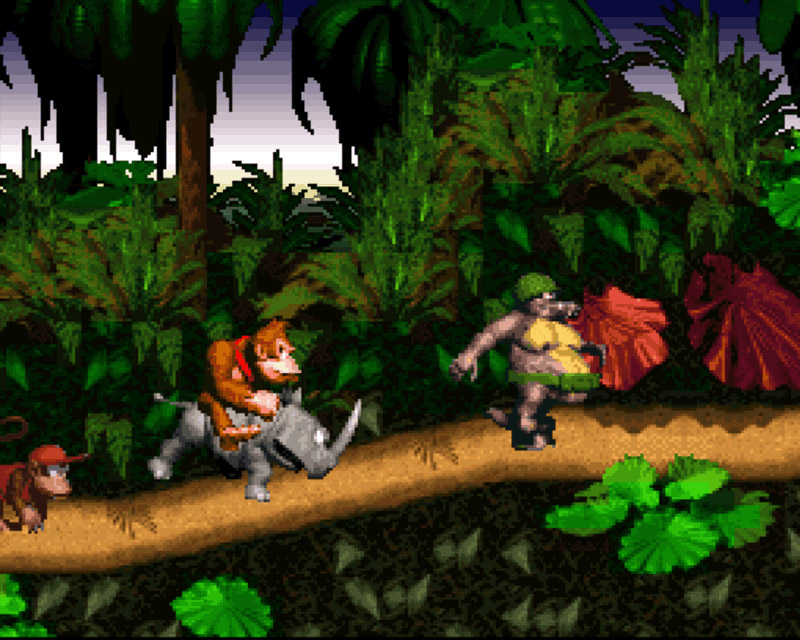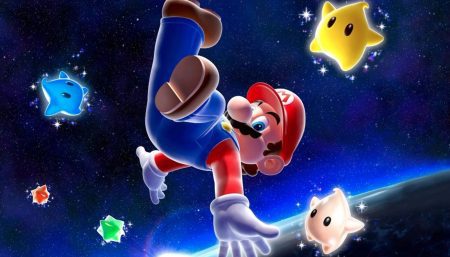How Donkey Kong Country Crafts a Foreboding Tale of the Unknown
Donkey Kong Country is among the finest 2D platformers ever and one of the best-looking and best-controlling games of its time. On the narrative front, however, many may find it lacking, as its plot is paper-thin and its playable characters never utter a word. Still, games like DKC stand the test of time through extraordinary gameplay, memorable music, and unique art styles, despite lacking the kinds of storytelling prowess of many of its contemporaries, such as Earthbound and Final Fantasy VI.
What if I told you, however, that Donkey Kong Country is arguably just as powerful story-wise as any of the text-heavy RPGs from the same era? What if I told you that a game featuring no conversations, exposition, or especially long cutscenes tells just as powerful a tale as games that do?
After taking the time to analyze the level design, presentation, and progression of this jungle-based platformer, I’ve concluded that Donkey Kong Country is not just a simple romp about a pair of charismatic apes exacting revenge on the monstrous pirate that stole from them; it’s a story about the difficulties of leaving one’s comfort zone and the terrors associated with traveling through the unknown. While none of the colorful characters ever say anything about these themes, the world design, level progression, graphics, and music tell a different tale.

What DKC is About
The skeleton of Donkey Kong Country’s plot is fairly straightforward: the Ape Who Wears A Tie discovers that King K. Rool, a large reptile-man who is both a pirate and a king, has stolen his enormous collection of bananas. Donkey Kong, along with his little buddy Diddy Kong, must travel outside his home of the Kongo Jungle and embark on an odyssey through a variety of challenging locations, including abandoned caves, ruins, and even a power plant, to finally confront his nemesis on a pirate ship, where the majority of the aforementioned bananas are kept (I assume the other bananas you collect throughout the game are either left behind by Mr. K. Rool or a way for Mr. Kong to replenish his collection of starchy fruit).
That’s pretty much it.
DKC is by no means the only game from its time with a limited plot, but even peers like Yoshi’s Island and Sonic the Hedgehog have greater stakes involved, namely the well-being of two infants and the freedom of dozens of forest critters, respectively. That said, nobody has ever played DKC expecting to find a deep and nuanced narrative structure. Still, the game’s Wikipedia explanation of its plot is shorter than that of the sitcom Scrubs, whose premise can be explained in a single sentence.
What DKC is Really About
Donkey Kong Country’s opening levels are exactly what you’d expect them to be. In the very first stage, Donkey Kong departs from his treehouse and enters the cave below, where he laments the absence of his banana hoard. From there, he and Diddy travel through a handful of levels defined by tropical flora and fauna, with crocodile-looking humanoids, abnormally large gophers, and terrifyingly large hornets peppered throughout. The environment fairly plainly presents a jungle, with plenty of grass, trees, rocks, and dirt, while the music in the background involves instruments we often associate with that kind of region, including conga drums and wooden xylophones.
In these moments, the titular hero is truly in his element, surrounded by his natural habitat and encountering the types of hazards one would (supposedly) come to expect in such a region. Kong, in his own niche, not only has the means and the knowhow to survive such hazards, but also has the help of his friends: Cranky Kong gives advice, Funky Kong helps the player travel between worlds (back when that was a crazy concept in video games, apparently), and Candy Kong lets the player save progress. In addition, in-level animal assistants such as Rambi the Rhinoceros and Enguard the Swordfish help Donkey Kong breeze through the early stages, a nod to how the apish protagonist has truly mastered his environment. Donkey and Diddy may be in some danger in the early stages, but they’re more than equipped to handle anything that comes their way.
This construct changes once you exit the first world, known as Kongo Jungle, and move on to the Monkey Mines, a curious region where nearly every level takes place in a cave or abandoned mine. The levels are darker, as they are of course underground, and the music changes from the lighter, cheerier tone from the first world…
…into something with a little more gravity and gloom:
From there you visit Vine Valley, which is more akin to North American forests than the aforementioned jungles. Most of the levels in this world take place in tree houses/platforms, with the exception of “Temple Tempest,” which takes place in what appears to be Mayan-inspired ruins. The protagonist and his cap-brandishing sidekick then head through the harsh snow and bitter ice caverns of Gorilla Glacier, whose visuals and soundtrack are as haunting as they come:
https://www.youtube.com/watch?v=wvCcz70lkXs
From here, Donkey Kong Country takes an interesting twist, as the next group of levels take place in what appears to be a nuclear power plant. These stages, the most bizarre in an already strange video game, are defined by steel platforms, burning oil drums, and a general air of industrial oppression. The colors are bland, the backdrops look almost too realistic (these levels reach the uncanny valley a number of times), and every single enemy seems out of place. Everything about this world, which is named Kremkroc Industries, makes the player somewhat uncomfortable, with dreary music, bleak visuals, and a total lack of the wonder that defined many of the previous levels.
Kremkroc Industries is such a crazy set of levels for a game about a gorilla wearing a tie, and it raises a number of questions: What exactly are they making in this factory? Why are all the oil drums on fire? How did all the woodland critters and crocodile humanoids end up in here? Why is the one water level loaded with toxic waste? How come you don’t see any factory workers there? If you think this world is weird, unsettling, and out of place, how do you think Donkey Kong and Diddy Kong feel?
The two apes make their way through another set of levels in caves or mine shafts until reaching the final boss fight against King K. Rool, which takes place on his pirate ship. After Donkey Kong has bested his scaly foe, he returns to his home in Kongo Jungle, where his banana hoard has been restored, much to his joy. After fighting through a litany of dire hazards, the titular hero can finally return to his home, where he belongs.
Closing Thoughts
There’s nothing particularly innovative or unique about the “stranger in a strange land” motif in video games, nor was the idea of moving from comfort to discomfort invented by Donkey Kong Country. That said, most games attempting to tell this kind of story do so through a great deal of exposition and depict the journey as something necessary for the greater good. The Legend of Zelda: The Wind Waker gives the player time to acknowledge their relationships with family and friends on Outset Island before Link must venture forth to save his sister. Assassin’s Creed Origins begins several long cutscenes culminating in the death of Bayek’s son, immediately motivating the player to exact revenge by leaving his hometown of Siwa to face greater forces of evil.
So why focus on the theme of exiting one’s comfort zone in Donkey Kong Country? Simply put, Donkey Kong doesn’t actually need to do anything. Nothing is really at stake other than his enormous collection of bananas and an implied thirst for vengeance. If he wanted to, he could have stayed in the comfort of his treehouse and started a new banana hoard (I mean, seriously, there are freaking bananas EVERYWHERE in the game). He could have spent the rest of his days hanging out with his friends far away from any danger and remaining in his natural habitat. The stakes of his adventures were minimal, yet he pressed on anyway, perhaps to finally see what lies ahead, no matter how frightening.
Donkey Kong Country was a visual marvel when it first rolled out in 1994. It helped push console gaming out of 2D, sprite-based graphics into an entirely new form of presentation and beauty. In many ways, Donkey Kong Country pushed Nintendo out of its comfort zone, just as King K. Rool pushed Donkey Kong out of his.
Sam has been playing video games since his earliest years and has been writing about them since 2016. He’s a big fan of Nintendo games and complaining about The Last of Us Part II. You either agree wholeheartedly with his opinions or despise them. There is no in between.
A lifelong New Yorker, Sam views gaming as far more than a silly little pastime, and hopes though critical analysis and in-depth reviews to better understand the medium's artistic merit.
Twitter: @sam_martinelli.














1 Comment
An excellent article. Also, the game’s fluid visuals and haunting urban soundtrack were something more commonly associated with Sega up to that point. Miyamoto was too harsh on the game because he’s always favoured gameplay and combination of a few simple ideas. DKC is far more an atmospheric mood piece. Mario games don’t tend to have much real sense of history to them – they’re mainly obstacle courses or playgrounds. DKC , by comparison , has a lived in feel more akin to Sonic’s Marble Zone than Mario. DKC was probably some influence on Metroid Prime in how that atmospheric use of ambient music , strident, peaceful, mysterious, can elevate a game to a sense of mysterious elegance and beauty. Otherworldly in a sense of diving in to places where few havd been before or where nothing friendly is still living.